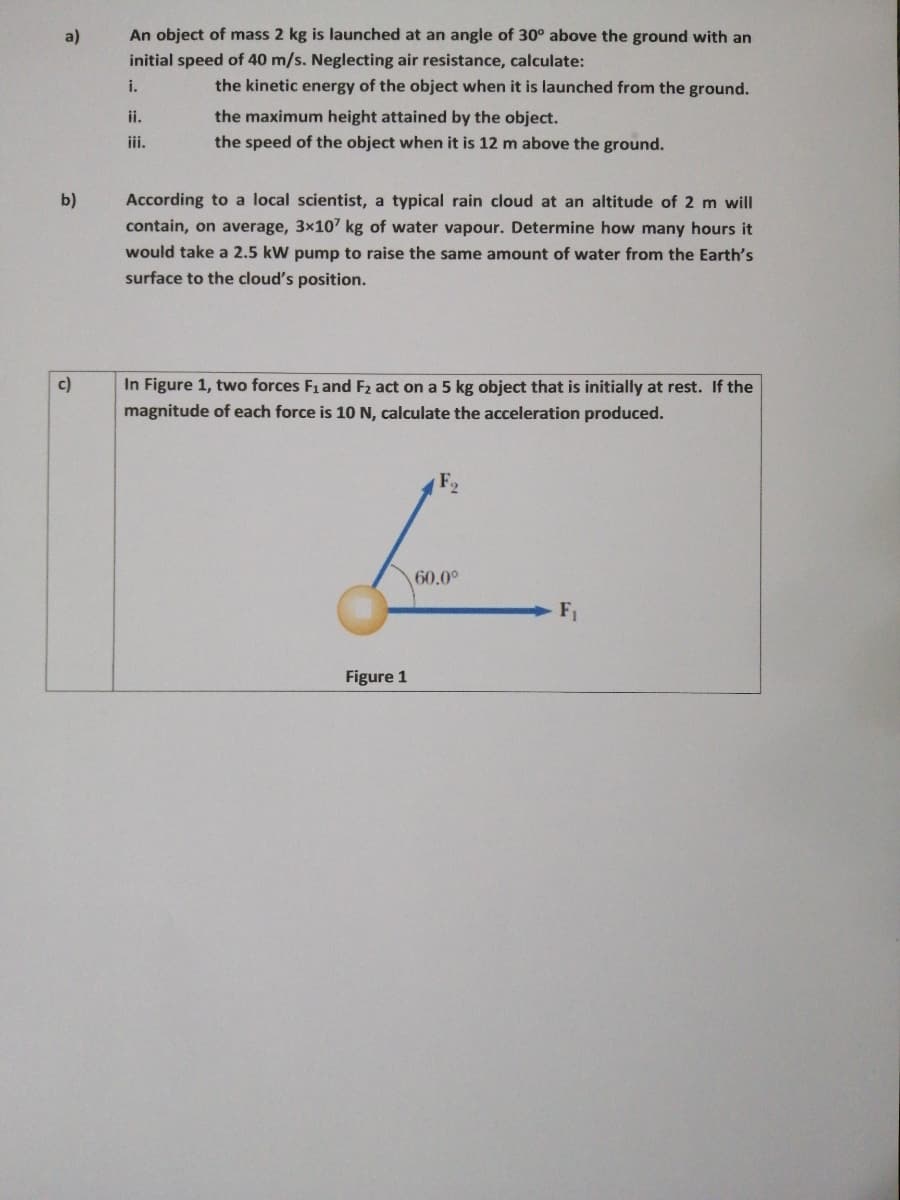An object of mass 2 kg is launched at an angle of 30° above the ground with an initial speed of 40 m/s. Neglecting air resistance, calculate: i. the kinetic energy of the object when it is launched from the ground. ii. the maximum height attained by the object. iii. the speed of the object when it is 12 m above the ground.
An object of mass 2 kg is launched at an angle of 30° above the ground with an initial speed of 40 m/s. Neglecting air resistance, calculate: i. the kinetic energy of the object when it is launched from the ground. ii. the maximum height attained by the object. iii. the speed of the object when it is 12 m above the ground.
Principles of Physics: A Calculus-Based Text
5th Edition
ISBN:9781133104261
Author:Raymond A. Serway, John W. Jewett
Publisher:Raymond A. Serway, John W. Jewett
Chapter7: Conservation Of Energy
Section: Chapter Questions
Problem 21P: A 5.00-kg block is set into motion up an inclined plane with an initial speed of i = 8.00 m/s (Fig....
Related questions
Question

Transcribed Image Text:a)
An object of mass 2 kg is launched at an angle of 30° above the ground with an
initial speed of 40 m/s. Neglecting air resistance, calculate:
i.
the kinetic energy of the object when it is launched from the ground.
ii.
the maximum height attained by the object.
iii.
the speed of the object when it is 12 m above the ground.
b)
According to a local scientist, a typical rain cloud at an altitude of 2 m will
contain, on average, 3x10' kg of water vapour. Determine how many hours it
would take a 2.5 kW pump to raise the same amount of water from the Earth's
surface to the cloud's position.
In Figure 1, two forces F1 and F2 act on a 5 kg object that is initially at rest. If the
magnitude of each force is 10 N, calculate the acceleration produced.
c)
60.0°
F1
Figure 1
Expert Solution
This question has been solved!
Explore an expertly crafted, step-by-step solution for a thorough understanding of key concepts.
Step by step
Solved in 3 steps with 3 images

Knowledge Booster
Learn more about
Need a deep-dive on the concept behind this application? Look no further. Learn more about this topic, physics and related others by exploring similar questions and additional content below.Recommended textbooks for you

Principles of Physics: A Calculus-Based Text
Physics
ISBN:
9781133104261
Author:
Raymond A. Serway, John W. Jewett
Publisher:
Cengage Learning

College Physics
Physics
ISBN:
9781285737027
Author:
Raymond A. Serway, Chris Vuille
Publisher:
Cengage Learning

University Physics Volume 1
Physics
ISBN:
9781938168277
Author:
William Moebs, Samuel J. Ling, Jeff Sanny
Publisher:
OpenStax - Rice University

Principles of Physics: A Calculus-Based Text
Physics
ISBN:
9781133104261
Author:
Raymond A. Serway, John W. Jewett
Publisher:
Cengage Learning

College Physics
Physics
ISBN:
9781285737027
Author:
Raymond A. Serway, Chris Vuille
Publisher:
Cengage Learning

University Physics Volume 1
Physics
ISBN:
9781938168277
Author:
William Moebs, Samuel J. Ling, Jeff Sanny
Publisher:
OpenStax - Rice University

College Physics
Physics
ISBN:
9781305952300
Author:
Raymond A. Serway, Chris Vuille
Publisher:
Cengage Learning

Physics for Scientists and Engineers with Modern …
Physics
ISBN:
9781337553292
Author:
Raymond A. Serway, John W. Jewett
Publisher:
Cengage Learning

Physics for Scientists and Engineers, Technology …
Physics
ISBN:
9781305116399
Author:
Raymond A. Serway, John W. Jewett
Publisher:
Cengage Learning